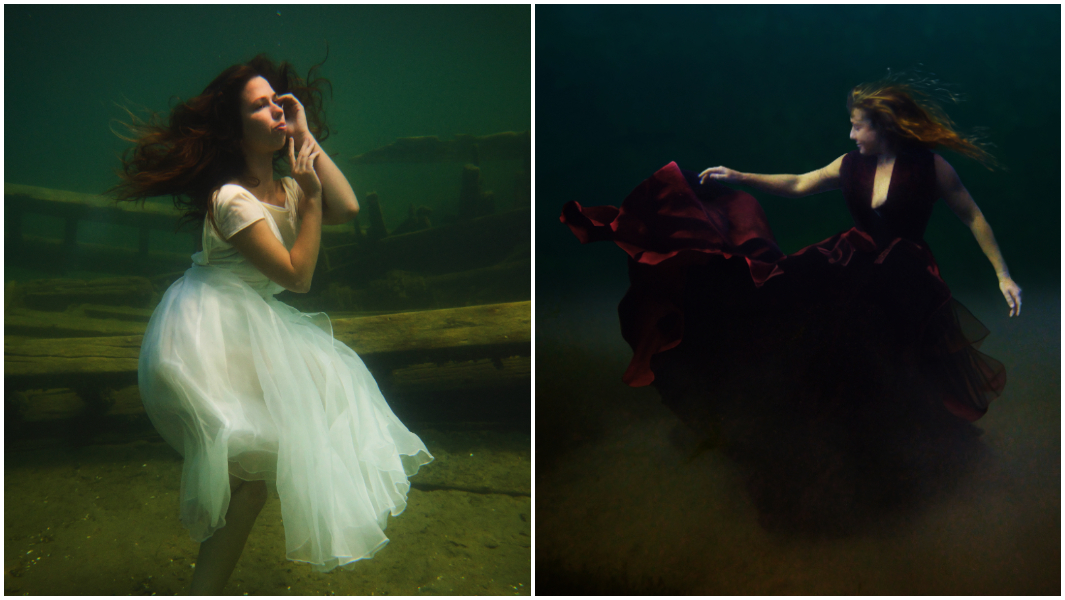Photographer and model dive even deeper to break underwater model photoshoot record

Just two years after first breaking the record for the deepest underwater model photoshoot, Steve Haining and his underwater photography crew have gone even deeper.
On 19 September, photographer Steven Haining, model Mareesha Klups, and safety diver Mario Medarevic staged an underwater photoshoot 30 m (98 ft) below the surface of Georgian Bay and Lake Huron, Ontario, Canada, beating their previous record by 23.6 m (77 ft).

The crew held a 16-minute photoshoot located at the bow of the Niagara II shipwreck.
They were motivated to break the record after initially breaking it on 26 June 2021.
“The first time we broke this record we kind of lit the fire of what is possible for this shoot and so we set off to go much deeper and much colder to see what we could pull off,” said Steve.
“We were so eager to get back and attempt this.”
The location they picked was an area the crew had dived before, although it was very cold and dark.
“You don’t need to go very deep to get a stunning photo, but we love the challenge,” said Steve.
“The darkness, the technical makeup of how to safely do a full production shoot at depth in the cold with limited visibility and the limited light really excited us.”
The photoshoot began with a shipwreck the team knew very well that happened to be sitting exactly where they wanted it to be.

Steve and his crew descended to the bottom of the lake to get the lighting and equipment ready before Mareesha jumped into the water.
Once Mareesha reached the bottom, the team unrolled the dress, removed the regulator, and started shooting.
The team then had to decide how to get the lighting to bring back enough colour to make the shot work and which camera lens to use.
“I always knew I wanted a really low shot from far enough away that you could see the scale of the wreck beside the model,” said Steve.
“When you just see normal underwater landscapes and pictures you often can’t tell how massive some things are under there and so I’m really grateful that some of those shots turned out how I imagined it.”
About 16 minutes into the shoot, Mareesha began getting muscle spasms from the cold and signaled for air from her safety diver.
The rest of the team collected the lighting equipment and began their ascent.

From setting up the photo shoot to resurfacing, the entire dive was around 33 minutes long.
“Once the last of us surfaced, we saw Mareesha was on the boat smiling and laughing even though the shoot was challenging, especially for her,” said Steve.
We were all super excited that we accomplished something so incredible.
Steve says creating photos underwater is really interesting because normally a photographer can see the moment, direct the art, and work with a subject to get the look they want.
Most of the time the model can also see the photos and provide ideas and feedback.
Underwater, you lose the entire aspect of portraiture, and the team really has to trust and understand each other and communicate well on the surface so that when they’re at depth they can actually bring ideas to life.

Steve says he thought it would be difficult to stay underwater for the entirety of the photo shoot.
However, because the crew was so rehearsed and focused on their safety and the job at hand, it didn’t feel that long.
It wasn’t until Mareesha started getting cold that they began to worry.
The main challenges besides the freezing cold temperature were visibility and coordination.
“When you’re that dark and there’s many people in the same area you have limited light and a lot of sediment in the water, so it creates its own challenge for the photo set,” said Steve.
“When you also add that the model can’t see and it's freezing cold the challenges start to stack and that’s why we made sure to use a very experienced dive master trainer as the model.”

Steve says family, friends, and people in the dive and photography community absolutely love the images, especially the ones from the record attempt.
“Anyone who knows the Niagara II wreck and sees the video footage knows how cold and difficult the water is around that wreck, especially at 30 metres,” said Steve.
“They can’t believe we actually accomplished it.”
For those interested in deep underwater photography, Steve says it’s important to find a really good team that prioritizes safety.
He also says most of the beautiful spots to shoot underwater are not much deeper than 50 feet, so it’s important to spend time building sets and shooting with models for long periods in warmer, more controlled safe waters before attempting any records.
Next, Steve would like to attempt a photoshoot at a high altitude.

“To know we officially beat our own record is incredible,” he said.
“I love that the Guinness World Records team gets as excited as we do when we push the limits even further.”
Want more? Follow us on Google News and across our social media channels to stay up-to-date with all things Guinness World Records! You can find us on Facebook, Twitter/X, Instagram, Threads, TikTok, LinkedIn, and Snapchat Discover.
Don't forget to check out our videos on YouTube and become part of our group chat by following the Guinness World Records WhatsApp channel.
Still not had enough? Click here to buy our latest book, filled to the brim with stories about our amazing record breakers.


